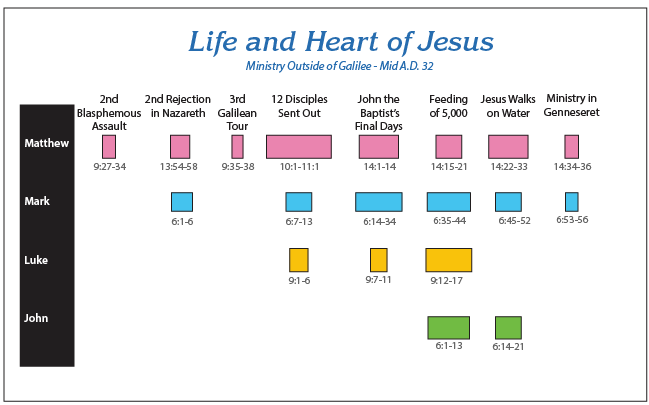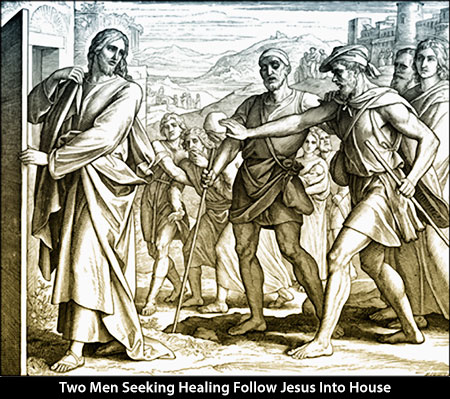The life of Christ is painted differently in each of the four gospels. The gospels of Matthew, Mark, Luke, and John are arranged differently and each contains some material that is unique to the individual book. For example, the gospel of Luke is chronological (Luke 1:3-4), but the gospel of Matthew is arranged topically. By comparing Matthew to Luke and Mark, we discover that Matthew has grouped most of the events in a different order so that he could paint a unique picture of Jesus as the Messiah (Matthew 1:1). Forty-two percent of Matthew is unique and cannot be found in the other three books. The material that is unique to Mark, Luke, and John is 7 percent, 59 percent, and 92 percent, respectively. Any study of the life of Christ that focuses on only one book will miss a lot of information from the other gospels. Therefore, in this study series of the Life of Christ, we are harmonizing all of the gospels. That is, we are putting all of the accounts from the four gospels in chronological order so that we can gain a better understanding of the life of Christ. For example, in Matthew 12:22-45, we discovered that the Pharisees had accused Jesus of performing miracles and wonders by demonic power. In response, Jesus had warned them not to commit the unpardonable sin. Now if we reorder the accounts in Matthew, we discover that Matthew 9:27-34 actually occurs chronologically after Matthew 12:22-45 even though it appears earlier in the book. This is an important point. That is, Matthew 12:22-45 has already occurred before this study which is about Matthew 9:27-34.
Background
When the Pharisees had blasphemed claiming that Jesus was not performing His miracles and wonders by the Holy Spirit, Jesus rebuked them and warned them of the consequences. Later Jesus surprised the crowd by telling them that anyone who does the will of God is His mother, brother, or sister (Matthew 12:46-50). Jesus’ point was that those who are in opposition do not belong to God’s family. Those who believe will honor, respect, obey, and follow God. Then Jesus shared the kingdom parables (Matthew 13). After escaping the crowds, He calmed a sea storm in order to rescue the disciples (Matthew 8:23-27). Next, Jesus expelled “legions” of demons from two men (Matthew 8:28-34), healed a woman with a flow of blood, and raised Jairus’ daughter (Matthew 9:18-26).
The parables explained the reason for the conflict with the religious leaders and the promise of an eternal future with God. Calming the sea proved that Jesus was God to His disciples, and the demons echoed that truth by calling Him the “Son of God.” When the woman with the flow of blood was healed, we discovered that power would flow from Him in the process of healing; and when Jesus raised the dead, it proved He was more than a mortal man. Now we will discover another claim that is unique to the gospel of Matthew.

On the pulpit of a great church, the Church of the Open Door, formerly located in downtown Los Angeles, California in the United States of America, there was a sign in the pulpit that preachers of the Christian faith saw when they approached to preach. The sign read, “Sir, we would see Jesus.” The message was that the congregation was not interested in “seeing” the speaker, nor were they interested in just an intellectual study of the Bible. That is also the goal of our studies. So far, we have seen Jesus in our studies. We have discovered God. He came and walked among us for a brief period of time. His name was Jesus and His actions proved His deity. This study is another glimpse of His majesty, grace, and power, and it occurred in the ancient city of Capernaum.
Two Blind Men
This study begins in the gospel of Matthew after Jesus raised Jairus’ daughter from the dead and left his home. We are told that two blind men started following Jesus when He left the house.
As Jesus went on from there, two blind men followed Him, crying out, “Have mercy on us, Son of David!” Matthew 9:27 (NASB)
These men called Jesus “Son of David.” The expression was a Jewish term which referred to the Messiah. Earlier, Jesus had declared that He was the Messiah to the woman at the well.
The woman said to Him, “I know that Messiah is coming (He who is called Christ); when that One comes, He will declare all things to us.” Jesus said to her, “I who speak to you am He.” John 4:25-26 (NASB)
The same message was communicated in a synagogue in Nazareth on a Sabbath morning (Luke 4:16-22). On that occasion, the people became angry because they did not believe Jesus was the Messiah. Jesus had quoted Isaiah 6:2, a passage that spoke of the Messiah, and then told them that He was the fulfillment of that prophecy. Isaiah 35:5-6 also described the Messiah,
Then the eyes of the blind will be opened and the ears of the deaf will be unstopped. Then the lame will leap like a deer, and the tongue of the mute will shout for joy. Isaiah 35:5-6 (NASB)
Jesus had quoted this passage to John the Baptist’s disciples as proof that He was the promised one – the Messiah (Matthew 11:5). Somehow these two blind men had discovered, knew, and believed that Jesus was their Messiah. They believed because of the testimony of others!

But how did these men find Jesus? We do not know. Were they brought by others to Jesus? If you were blind, how would you have found Jesus? How would you have felt? If you were blind how would you know which direction to move in order to find Jesus? The answer is obvious. You would not know which way to move, except by listening or having someone guiding you. When they heard that Jesus had passed by them, they started following and shouting loudly, “Have mercy on us, Son of David!” The Greek phrase translated as “crying out” starts with krazo. It means “to cry out loudly.” That is, they were shouting in order to be heard above the noise of the crowd. But Jesus did not stop. He kept on walking. Why did Jesus not stop? We will discover in the next verse that apparently He wanted to heal the men in a more private setting and wanted them to follow.
The Healing
When Jesus reached the house of Peter, the two blind men walked in after Him. Then Jesus stopped and asked them a question.
When He entered the house, the blind men came up to Him, and Jesus said to them, “Do you believe that I am able to do this?” They said to Him, “Yes, Lord.” Matthew 9:28 (NASB)
His question was simple and the men’s response was simple, “Yes!” They believed that Jesus could heal them. These men may have been physically blind, but they had great spiritual sight. They knew that He was the Messiah and they believed He could heal them. So they came!
Then He touched their eyes, saying, “It shall be done to you according to your faith.” Matthew 9:29 (NASB)
Some have taught that faith is required in order to be healed. But as we discovered in the last study, Jesus healed on occasions when people were dead or demon-possessed. Dead people do not have faith, and demon possessed people do not have faith. Jesus healed many times when faith was not required. But those who came to Him for healing would have had at least some faith, or they would not have come to Him. Why would anyone come if he or she did not believe He could heal?
If we review every passage in the gospels that refers to healing, we find an amazing truth. First, eighty-six percent of all passages that refer to faith in conjunction with healing, refer to people who have already come to faith in Jesus. That is, they were believers in Jesus Christ. Here are a few obvious examples,
And they brought to Him a paralytic lying on a bed. Seeing their faith, Jesus said to the paralytic, “Take courage, son; your sins are forgiven.” Matthew 9:2 (NASB)
And He said to the woman, “Your faith has saved you; go in peace.” Luke 7:50 (NASB)
Many times the passages reveal that the one being healed already believed in Him, because he or she called Jesus the “Son of David.” They believed that He was the Messiah (Matthew 9:27-29; Mark 10:48, 52) and healing followed.
Maybe one of the clearest examples is the time that Jesus healed ten lepers. Even though all ten lepers were healed, only one remained to thank Jesus. Now consider what Jesus said to him,
Then Jesus answered and said, “Were there not ten cleansed? But the nine—where are they? Was no one found who returned to give glory to God, except this foreigner?” And He said to him, “Stand up and go; your faith has made you well.” Luke 17:17-19 (NASB)
Why is this man unique? If he is unique because he believed in Jesus, then why were the other men healed? It is obvious that the other nine men believed that Jesus could heal them or they would not have sought Him. They asked Jesus to heal them because they believed He could. In that sense, their faith enabled them to be healed.
In the remaining fourteen percent of the references to faith and healing, Jesus simply referred to the fact that they had faith or that they believed. There is no clear evidence that faith or belief was the activating ingredient for their healing (Matthew 8:10; Luke 7:9).
In fact, God wants every Christian to believe in Him and to live by faith (Romans 1:17; Galatians 3:11; Hebrews 10:38). God expects us to trust confidently Him for the things that we request (Mark 11:24; James 1:5-6). Faith is expected when we ask God for anything. If we are not sure He can answer our request, then we should not ask. Why ask if we are not sure He can fulfill our request? Yet, we cannot expect that He will grant our every wish. We must not forget the following passage which the Holy Spirit wrote,
This is the confidence which we have before Him, that, if we ask anything according to His will, He hears us. And if we know that He hears us in whatever we ask, we know that we have the requests which we have asked from Him. 1 John 5:14-15 (NASB)
Our requests may not be according to His will and sometimes we may ask with wrong motives (James 4:2-3). So sometimes His answer to our prayer is, “No!”

Eyes Opened
After Jesus touched the eyes of these two blind men, they could see.
And their eyes were opened. And Jesus sternly warned them: “See that no one knows about this!” Matthew 9:30 (NASB)
The ancient writer Hillary wrote these insightful words,
The blind men saw because they believed; they did not believe because they saw.[1]
It is amazing that Jesus told them not to tell others. Surely, Jesus knew that people would discover that the men were no longer blind. We will discover in the next two verses that people were already present. So why did Jesus ask them not to talk about the healing? It appears that Jesus did not want these people to conclude that He was the Messiah yet. Eventually, the healing would become known. But the two men did not cooperate. They told everyone anyway.
But they went out and spread the news about Him throughout all that land. Matthew 9:31 (NASB)
Another Demon Expelled
As soon as the two men left, a demon-possessed man was brought to Jesus.
As they were going out, a mute, demon-possessed man was brought to Him.” Matthew 9:32 (NASB)
The New American Standard Bible says that the man was “mute,” but the Greek word for “mute” is kophos. It can actually mean “mute” or “deaf” and sometimes it referred to both at the same time. Therefore, it is very possible that the man was both deaf and mute. The next verse implies that at least he was not able to speak. Then Jesus healed him.
After the demon was cast out, the mute man spoke; and the crowds were amazed, and were saying, “Nothing like this has ever been seen in Israel.” Matthew 9:33 (NASB)
The crowd could not believe what they had witnessed. They had never seen anything like this before in Israel. The Greek actually says, “Never!”
Second Blasphemous Rejection
Now we discover that some religious leaders are present. They had been there all the time, listening and watching. Previously the Pharisees had accused Jesus of performing miracles by demonic power (Matthew 12:22-45). But after seeing this miracle and hearing the response of the crowd, they did it again.
But the Pharisees were saying, “He casts out the demons by the ruler of the demons.” Matthew 9:34 (NASB)
This is just an incredible response after Jesus had just recently cast out “legions” of demons, raised the dead, healed two blind men and now this demon-possessed man. The religious leaders did not deny that Jesus did the miracles; they just had another explanation. They twisted the facts in an attempt to keep the people from following Jesus as the Messiah. They were religious politicians without integrity. They did not care about the truth, because they were jealous of Jesus (Matthew 27:18; Mark 15:10). Envy may be one of the most common problems in the church today.
When the people started responding, and as Jesus’ popularity increased, the religious leaders “went to war” against Jesus. They slandered His character repeatedly. A dear friend commented once that every time he asked a certain layman in the church to preach, he found jealously in his heart toward that individual. He said that he would worry about what others thought of the man’s speaking ability and compare the layman’s ability to his own. It was always a humbling experience for the pastor. My friend responded with integrity and honored the Lord by realizing that God has uniquely gifted all of us for the benefit of Christians.
But the Jewish religious leaders did not respond that way. Because of their envy they forcefully confronted Jesus on numerous occasions and if necessary would lie about Him. Their goal was to ruin Jesus’ reputation and cast doubt on His credibility. Ultimately, they had Him murdered.
Conclusion
The goal in the Christian life is to give honor to every believer. God has given each believer to the body of Christ for a purpose – to edify others (1 Corinthians 12:12-25). The goal of edification is to make us spiritually mature (Ephesians 4:11-16; Colossians 1:28). In Hebrews 10:24-25 we are told that we need to provoke one another to love and good deeds. We are to be models of godliness and spiritual maturity so that others will know how to become fathers in the faith (Hebrews 6:11-12; 13:7; 1 John 2:12-14). That is, there is no place for envy within the church.
Besides, envy is a sin and it displeases God. If the Pharisees had been spiritually mature, they would have supported Jesus and given Him honor. But they did not do that, and the result is recorded in the passages of the Bible and in the documents of ancient writers. They killed Him! Unfortunately, today some followers of Jesus Christ are being slandered and “killed” in a figurative sense. But God has called us to be men and women of peace. The true test of a man or woman of God is his or her willingness to allow another believer whom God is clearly blessing to take his or her ministry.
Ron Dunn tells a story about a woman who had been teaching an adult Sunday School class for many years. In his illustration he states that the leaders of the church had decided that it is time for another person to begin teaching the class. But when the woman was told that she would no longer be teaching, she was extremely disappointed. Her inner attitude was wrong. Then Ron made the point that her response revealed whom she was really serving – herself. She was more concerned about herself than the need to disciple and train another Bible teacher. In the same way, God has called us to train or disciple other men and women to carry on the ministry. Envy should never be a problem in the Christian life. Our goal should be to make disciples for the glory of the Lord.
References:
1. Hilary of Potiers. On Matthew.